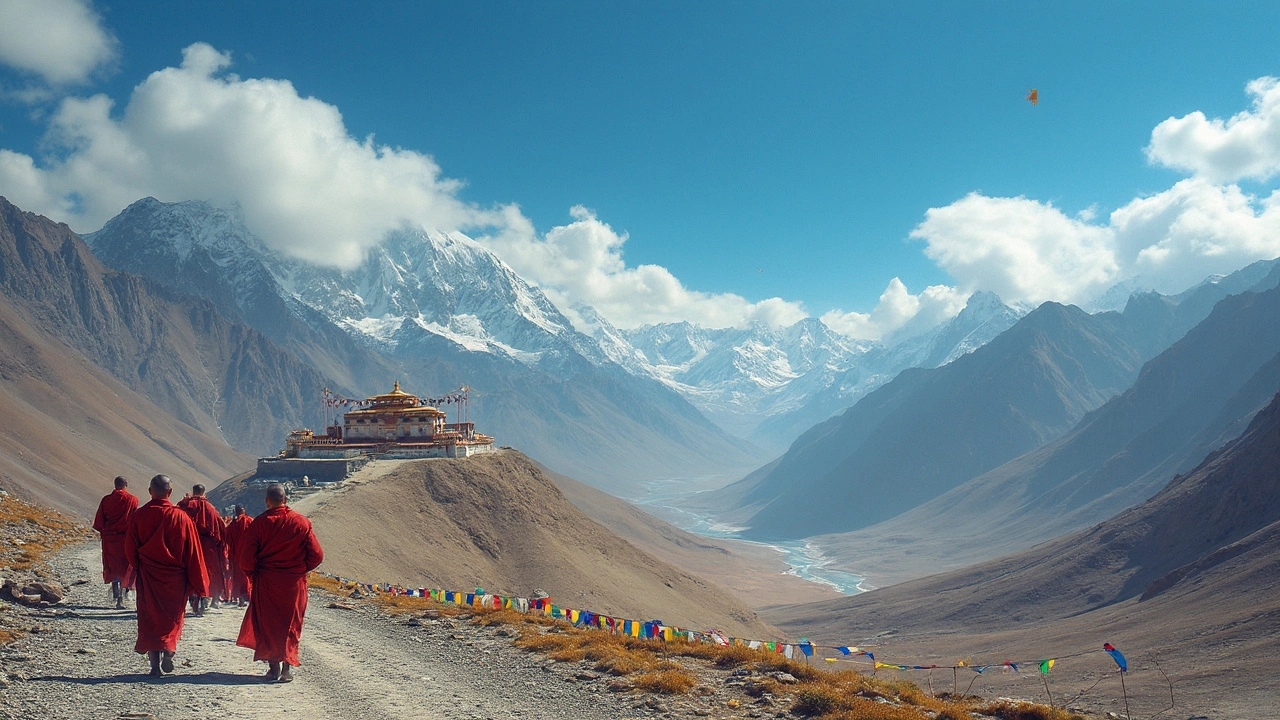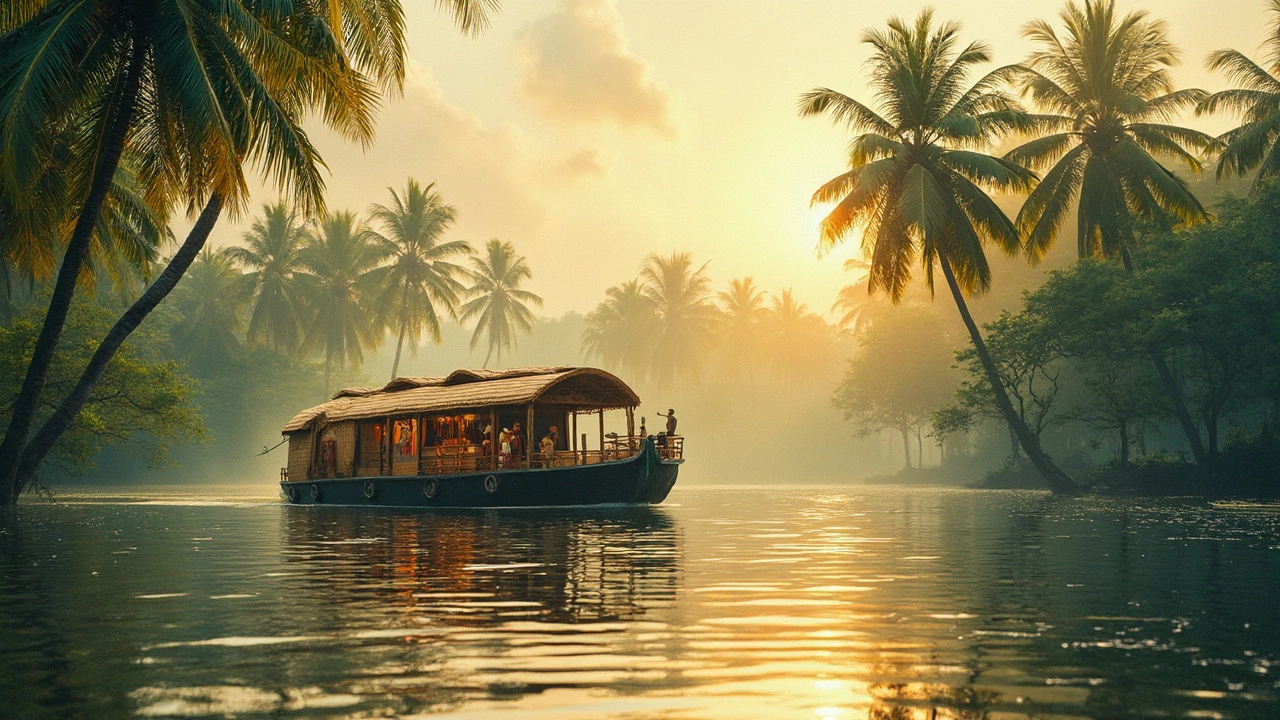So, Kerala and Ladakh: two places in India, yet worlds apart. Imagine Kerala as the land of coconuts, backwaters, and everything green. It's where you can float lazily on a houseboat and sip fresh coconut water. On the flip side, Ladakh feels like a different planet with its stark mountains, monasteries perched on hills, and crystal-clear skies.
Let's talk numbers. Kerala sits near sea level, enjoying a tropical climate. Ladakh, meanwhile, soars at altitudes over 10,000 feet, with winters that can chill your bones. So, pack accordingly—think light layers for Kerala and a serious winter wardrobe for Ladakh.
Geography and Climate
When it comes to geography, Kerala and Ladakh couldn't be more different. Kerala stretches along India's southwestern coastline, making the Arabian Sea its neighbor. This means beaches galore and a tropical vibe that's impossible to miss. It's not just beaches though; Kerala's got rolling hills like Munnar with tea gardens that smell like heaven.
Now, picture Ladakh. Nestled in the northern part of India, it's a high-altitude desert, almost touching the sky. With the mighty Himalayas surrounding it, you're looking at raw, otherworldly landscapes. It’s like stepping into a serene painting of rocky terrains—truly a nomad's paradise.
According to the Indian Meteorological Department, "Ladakh is one of the highest regions in the world, with much of it being over 3,000 meters (9,800 ft). It experiences extreme climatic conditions."
Now, about the climate. Kerala enjoys a tropical climate with plentiful rainfall, especially during the monsoon months of June through September. Packing an umbrella isn't a bad idea if you're traveling to Kerala during this time. On the other hand, Ladakh's climate is one of extremes. Summers are short but pleasant, while winters can be frigidly cold with temperatures dropping well below freezing. Best to visit Ladakh between May and September when the weather won't chase you indoors!
Weather Tips
- Kerala: Light and breathable clothes work best. Don't forget waterproof gear for the rains!
- Ladakh: Go for layers. A good pair of thermal wear and a solid jacket can be lifesavers.
In essence, when traveling to these regions, the contrasting climates mean you should pack differently. Kerala calls for beachwear and possibly an umbrella, while Ladakh demands thermals and a taste for adventure!
Cultural Flavors
When you talk about Kerala and Ladakh, you're diving into two completely different worlds of culture and tradition. It's like comparing spicy curry to a hot cup of butter tea. Both are part of the incredible Indian tapestry, but they offer distinctly unique experiences.
Traditions and Festivals in Kerala
Kerala is vibrant and colorful, known for its elaborate festivals like Onam with its intricate flower carpets and traditional boat races. It’s a celebration that calls for delicious feasts and traditional dances. Kathakali, with its elaborate costumes and makeup, is a dance form that will leave you spellbound. This is where the culture truly comes alive!
Spirituality and Monasteries in Ladakh
Now, shift gears to Ladakh, and it feels like entering a peaceful monastery. Monasteries like Hemis and Thiksey are not just places of worship—they're cultural landmarks. The Hemis Festival, with its masked dances and rituals, is something you wouldn't want to miss. The blend of Buddhist traditions with a serene landscape is what makes Ladakh's culture so captivating.
Art and Architecture
The architecture tells another story. Kerala boasts majestic temples and churches like the Padmanabhaswamy Temple, a masterpiece of Dravidian design. Ladakh, on the other hand, has gompas like the Diskit Monastery, where spirituality meets stunning artistry. The whitewashed stupas set against the endless blue sky form a picture-perfect view.
So, whether it’s the intricate artistry of Kerala or the soul-soothing spirituality of Ladakh, both offer a cultural immersion worth every moment. Each place, with its unique flavors, contributes to the rich diversity of Indian culture.

Adventure and Activities
When it comes to adventure and fun activities, both Kerala and Ladakh have their unique offerings that cater to thrill seekers and tranquility lovers alike.
Trekking and Hiking
Ladakh is a hiker's paradise, offering some of the most breathtaking trekking routes. One of the highlights is the Chadar Trek, where you literally walk on the frozen Zanskar River—pretty intense, right? Meanwhile, Kerala offers a more lush experience. The Western Ghats offer trekkers trails through dense green forests. If you like your adventures a bit less chilly, Kerala might be your go-to.
Water Activities
Kerala takes the prize for water-based activities. You can enjoy kayaking in the serene backwaters of Alleppey or diving off the coast near Kovalam. Don’t forget to try the houseboat experience for something calmer. Ladakh, nestled in the Himalayas, takes advantage of the rivers for rafting. The Zanskar River, especially, offers rapids that are sure to raise your adrenaline levels.
Unique Experiences
Ladakh is famous for its motorcycle touring culture. The Leh-Manali Highway is a must-experience for bikers. On the other hand, Kerala offers the unique experience of Ayurvedic spa treatments, which might not be thrilling in the traditional sense, but can be revitalizing in its own way.
"Adventure is worthwhile." - Aesop
This quote perfectly sums up why these activities are so popular among visitors to both regions.
Stats and Facts
If numbers are your thing, here’s a quick comparison:
| Activity | Kerala | Ladakh |
|---|---|---|
| Trekking Routes | 15+ | 30+ |
| Popular Water Activities | Kayaking, Houseboats | Rafting |
| Best Season | September to March | June to September |
Food and Cuisine
When it comes to food, Kerala and Ladakh offer flavors that couldn't be more different. Kerala is famous for its spicy curries, fragrant rice dishes, and coconut-infused everything. Picture yourself enjoying a plate of fish curry with steaming hot rice by the backwaters. Some must-tries include 'Sadya', a feast served on a banana leaf, and the lip-smacking 'Appam' with stew.
On the other hand, Ladakh brings you rustic and hearty meals, perfect for its chilling weather. One can't miss the traditional 'Thukpa', a comforting noodle soup, and 'Momo', mouthwatering dumplings that are practically street food royalty there. Also, give the salty butter tea a go—trust me, it's a unique experience.
Cooking Styles
Kerala's cuisine is all about using fresh ingredients and lots of spices. The state boasts an incredible variety of vegetarian and non-vegetarian dishes that are prepared with traditional methods like steaming, frying, and roasting.
In contrast, cooking in Ladakh often involves drying and fermenting techniques, owing to its climate. Ingredients like barley, yak butter, and root vegetables dominate the scene, making for simple yet nourishing meals.
Key Ingredients
- In Kerala: Coconut, rice, chillies, and fresh fish.
- In Ladakh: Barley, dried meats, and root vegetables.
Whether you're a spice lover or looking for something to cozy up your palate, both destinations offer an authentic journey through flavors that tell stories of culture and tradition. So, are you more of a coconut curry fan or a dumpling adventurer?
